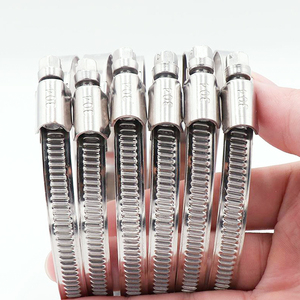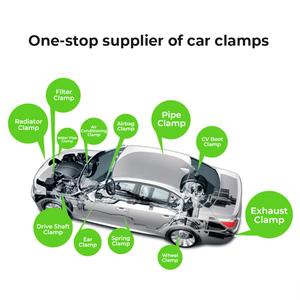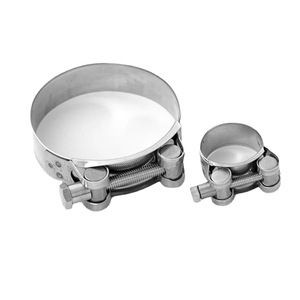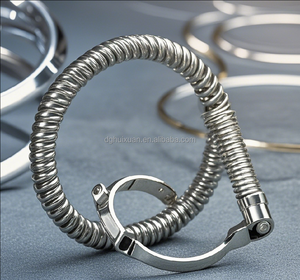
All categories
Featured selections
Trade Assurance
Buyer Central
Help Center
Get the app
Become a supplier

(998 products available)
































Compression hose clamps come in a variety of shapes. Selecting the proper type is essential for suitable application and performance. The following are the most common types of compression hose clamps:
Band clamps
Band clamps exert uniform pressure around the entire circumference of a hose. They are typically constructed from a wide metallic band. Band clamps are ideal for heavy-duty applications where a tight, leak-proof seal is necessary. Their even pressure distribution makes them suitable for high-pressure environments.
Screw and bolt clamps
This kind of clamp tightens by rotating a screw or bolt. These are simple and effective. Screw and bolt clamps allow precise adjustment for the desired compression level. This feature offers great flexibility for a variety of applications. These are common in automotive and industrial systems.
Cobra clamps
Cobra clamps are named for their resemblance to a snake. They have a double-lever mechanism that allows quick adjustments and locking in place. These tension clamps are frequently used in woodworking and metalworking. This is because they provide fast and strong compression where the desired object needs to be secured temporarily.
Spring tension clamps
Spring tension clamps use a tensioned spring to apply pressure. This kind of clamp is beneficial when a constant force is required. It also accommodates slight changes in dimensions of the parts being clamped. It possesses both elasticity and durability. These features make them useful for welding or soldering. This is where one needs to account for thermal expansion.
Pipe clamps
Pipe clamps, as the name suggests, secure and compress pipes. This type of clamp ensures a leak-free seal in pipe connections by evenly distributing pressure around the pipe's surface. Most of these clamps are made of stainless steel. This gives them resistance to corrosion and durability, making them ideal for both water and gas pipelines.
Stainless steel
Compression hose clamps are mostly made of stainless steel, combining strength with excellent corrosion resistance. Stainless steel is extremely durable. It does not warp or weaken with frequent use or under extreme conditions. It also withstands moisture, temperature fluctuations, and exposure to chemicals. Such features make it ideal for industries such as automotive, marine, and chemical processing.
Carbon steel coated with zinc
Carbon steel is a tougher material, though often cheaper, than stainless steel. It is ideal for many applications that do not require immediate exposure to moisture or aggressive chemicals. To enhance corrosion resistance, carbon steel clamps are coated in a thin layer of zinc. Zinc offers a protective barrier against oxidation. This makes carbon steel clamps useful in less demanding outdoor or industrial settings.
Aluminum
Aluminum compression hose clamps are lightweight and relatively resistant to corrosion at a lower cost than stainless steel. While not as strong as steel, aluminum is useful for low to moderate pressure applications where weight is the primary concern. It is mainly found in automotive and aerospace industries where every gram matters.
Copper
Copper is a highly malleable and durable metal with great corrosion resistance. Copper compression clamps are often used in plumbing and electrical applications. This is because they provide a reliable and long-lasting connection. However, copper is softer so it can wear down more easily than harder metals in high-stress environments.
Plastic composites
High-strength plastic composites found in compression hose clamps are designed to resist corrosion from moisture and chemicals. These materials are significantly less harmful than metal overlays on the environment. Plastic composite clamps are ideal for applications where electrical insulation or low weight is necessary. This is especially needed in the chemical industry and other moisture-prone environments.
Automotive industry
The automotive industry incorporates compression hose clamps into car cooling and fuel systems. These clamps are useful for securing radiator hoses, fuel lines, and vacuum hoses. All these are vital for the smooth operation of the vehicle's engine. Therefore, the clamps prevent leaks and ensure the right pressure. This is why they are necessary for reliable vehicle operation.
Hydraulic systems
Compression hose clamps are important components in hydraulic machinery and equipment in industries like mining, construction, and manufacturing. They securely fasten hydraulic hoses under high-pressure situations. The primary role of these clamps is to prevent costly fluid leaks and potential system failures. This risks not only damage to the machinery but also safety hazards to the employees.
Refrigeration systems
In commercial refrigeration and air conditioning systems, compressors and hose clamps secure refrigerant lines. This helps maintain the right pressure and prevents leaks that reduce the system’s efficiency. Retail stores, restaurants, and warehouses that hold perishable products depend on these clamps. They ensure that refrigeration systems operate effectively and safely.
Aerospace industry
In the aerospace industry, where both safety and performance are critical, compression hose clamps are extensively used. They are involved in securing fuel hoses and vent lines, among other vital aircraft systems. The durability and lightweight nature of these clamps help maintain the integrity of critical systems at high altitudes and in extreme temperatures. This provides a safer operation.
Pumping systems
The use of compression hose clamps in agricultural irrigation and water pumping systems is not uncommon. These clamps are used to hold hoses and pipes together, ensuring that water flows without leaks. These clamps are especially helpful in the fields where efficiency is crucial. Tight seals prevent wastage of water, reduce disease transmission in crops, and minimize equipment downtime.
Application requirements
Knowing what the application needs will go a long way in selecting the right compression hose clamp. For example, the industry may require clamps to handle high-pressure or high-temperature fluids. Others may just need low-pressure water transport. The application will also help determine whether one needs a permanent or movable clamp.
Materials involved
Both the hose and the fitting should be in mind when choosing a clamp. The right clamp material should be compatible with these two elements. Therefore, ensure the material of the clamp selected will not be affected by the hose or fitting materials. This helps to avoid premature failure from chemical attack. Additionally, one should consider the environment. For example, exposure to moisture may require a corrosion-resistant material like stainless steel.
Size and adjustability
The compression hose clamp's size should match the hose diameter precisely. This ensures an even and tight seal with no potential for leakage. Adjustable clamps also come in handy. They could be a perfect option when minor differences in hose sizes are present, or future changes need to be accommodated.
Ease of installation
How easy is it to install? Certain designs offer quicker installation without special tools. For example, screw and bolt clamps often require simple tools for tightening. On the other hand, some may require more complex or time-consuming installation procedures.
Cost considerations
Cost is a crucial factor in any business setting. It is, however, very important to analyze the price of the compression hose clamp concerning its performance and longevity. Sometimes, the higher initial costs of a durable, high-quality clamp may be more advantageous in the long run than a cheaper alternative.
These are widely used in various industries to secure hoses in place. They are especially used to prevent leaks in fluid transfer systems. Common applications include car cooling systems, hydraulic machinery, and plumbing.
A hose clamp is used to secure a flexible hose to a fitting by tightly pinching the hose, which creates a seal. On the other hand, a compression clamp is often used in electrical circuits to secure and compress materials like conductors, maintaining proper contact and conductivity.
Compression hose clamps are mostly made from stainless steel, carbon steel with zinc coating, aluminum, copper, and plastic composites. Stainless steel is preferred in most industrial applications because of its strength and corrosion resistance.
Screw and bolt clamps and adjustable clamps are easily reusable. They can be retightened or readjusted multiple times. Others, like band clamps, are not designed for repeated use so they can wear out or lose their sealing effectiveness after initial installation.
To ensure a proper seal with a compression hose clamp, select a clamp of the right size and material. The right size hose means the clamp should fit the hose diameter without being too tight or too loose. Properly position the clamp on the hose at the correct distance from the fitting. Evenly distribute the compression by tightening it slowly and uniformly. Use a torque wrench, where applicable, to meet the manufacturer's specified tightness.